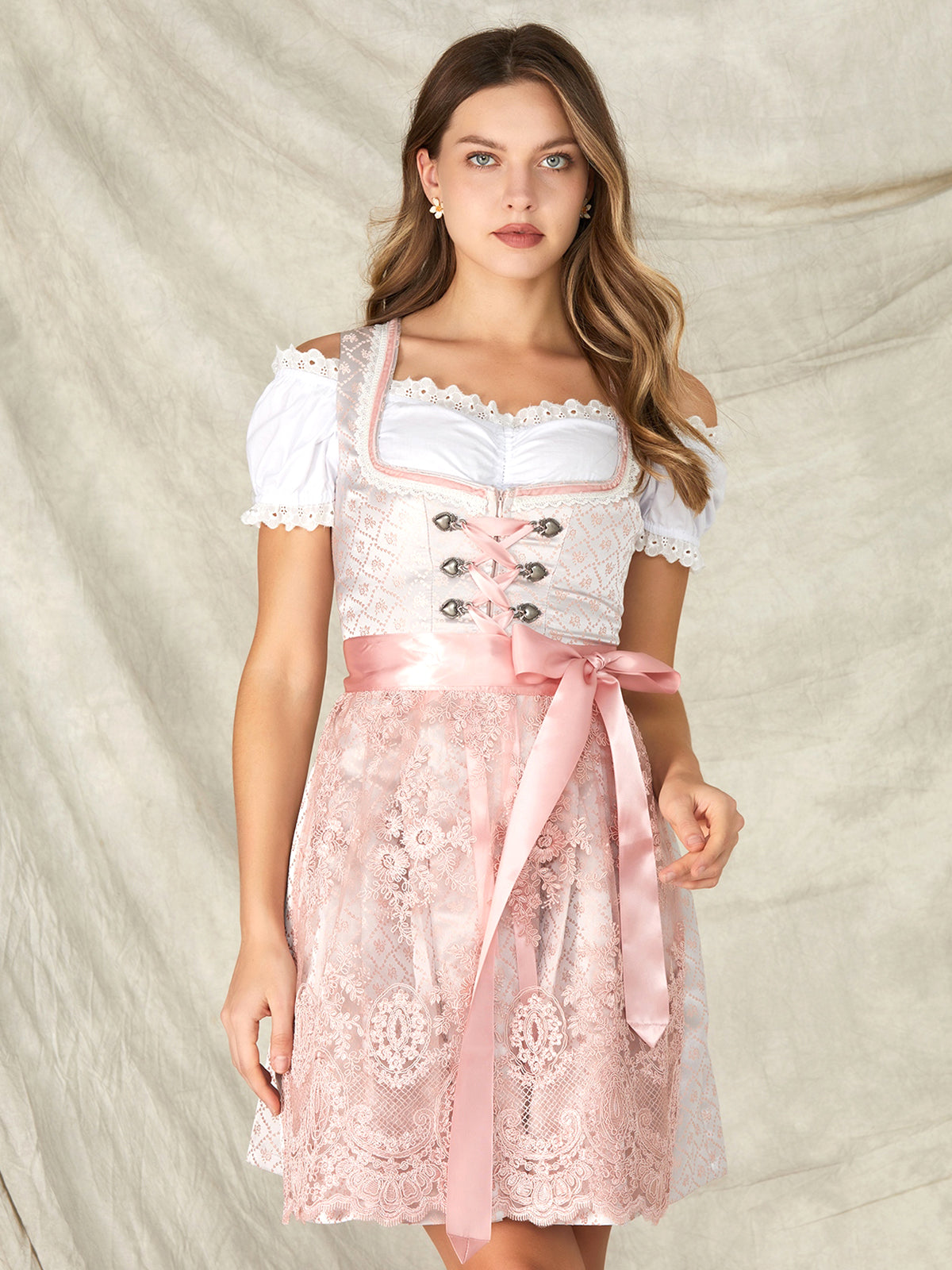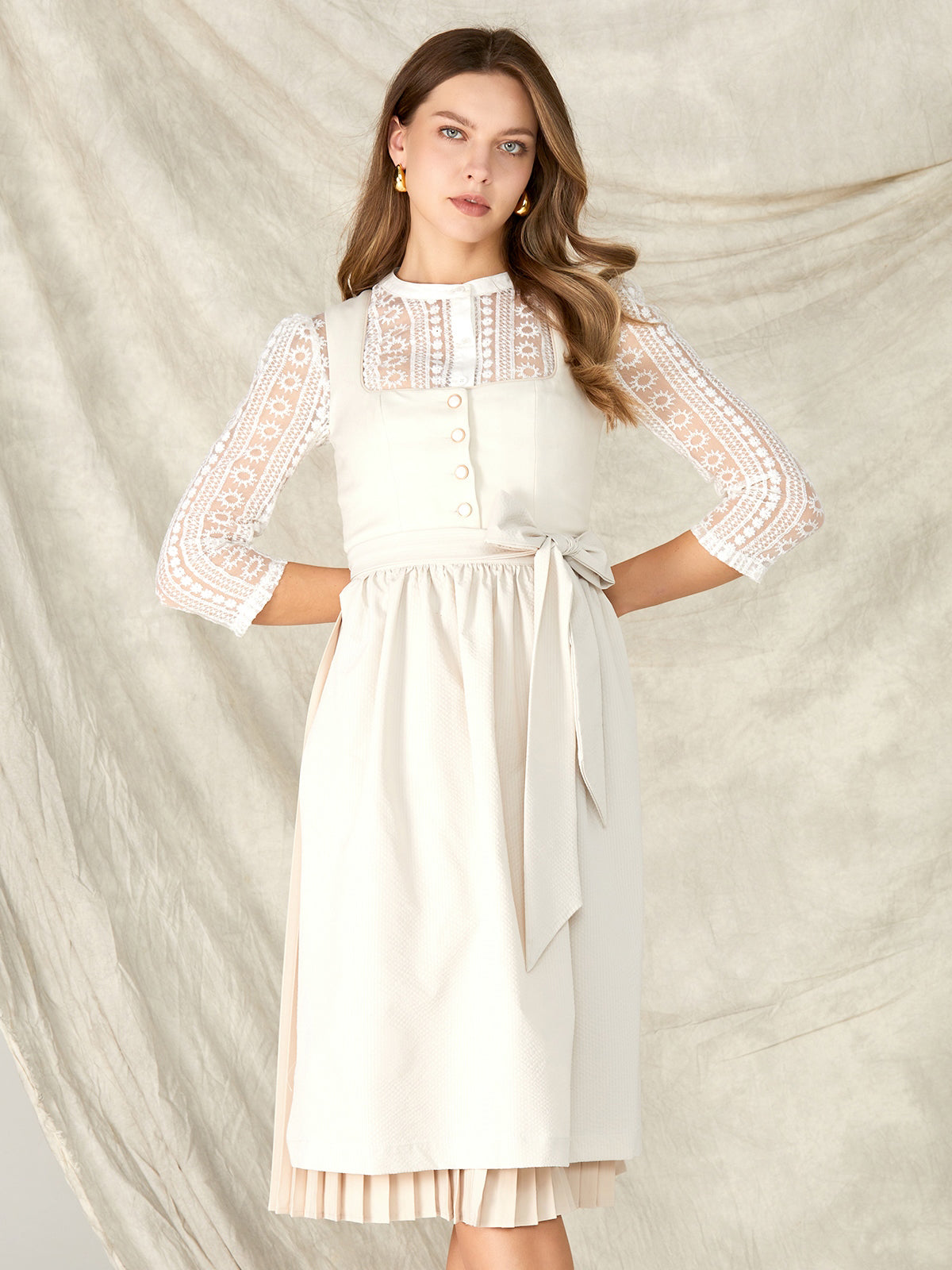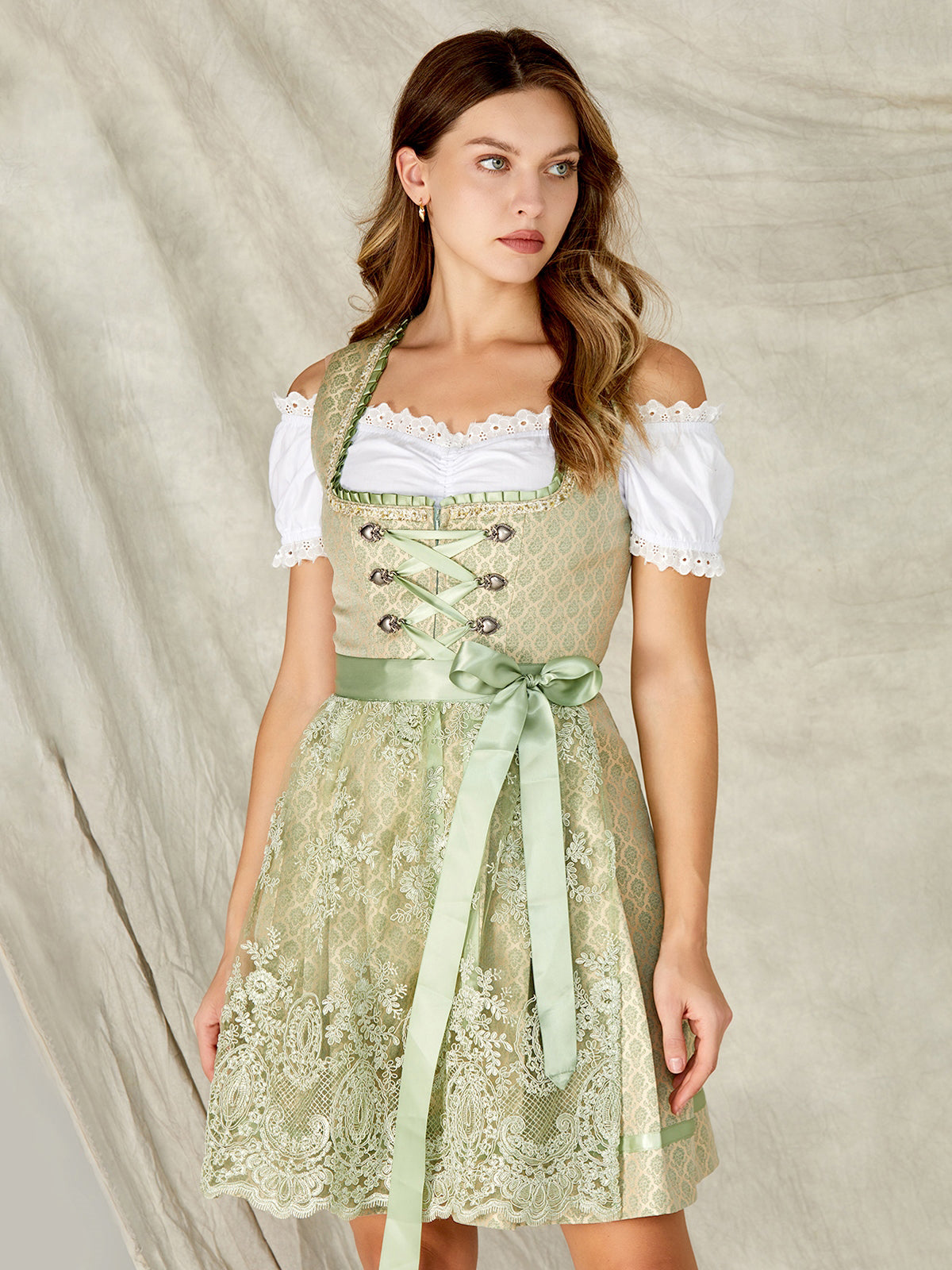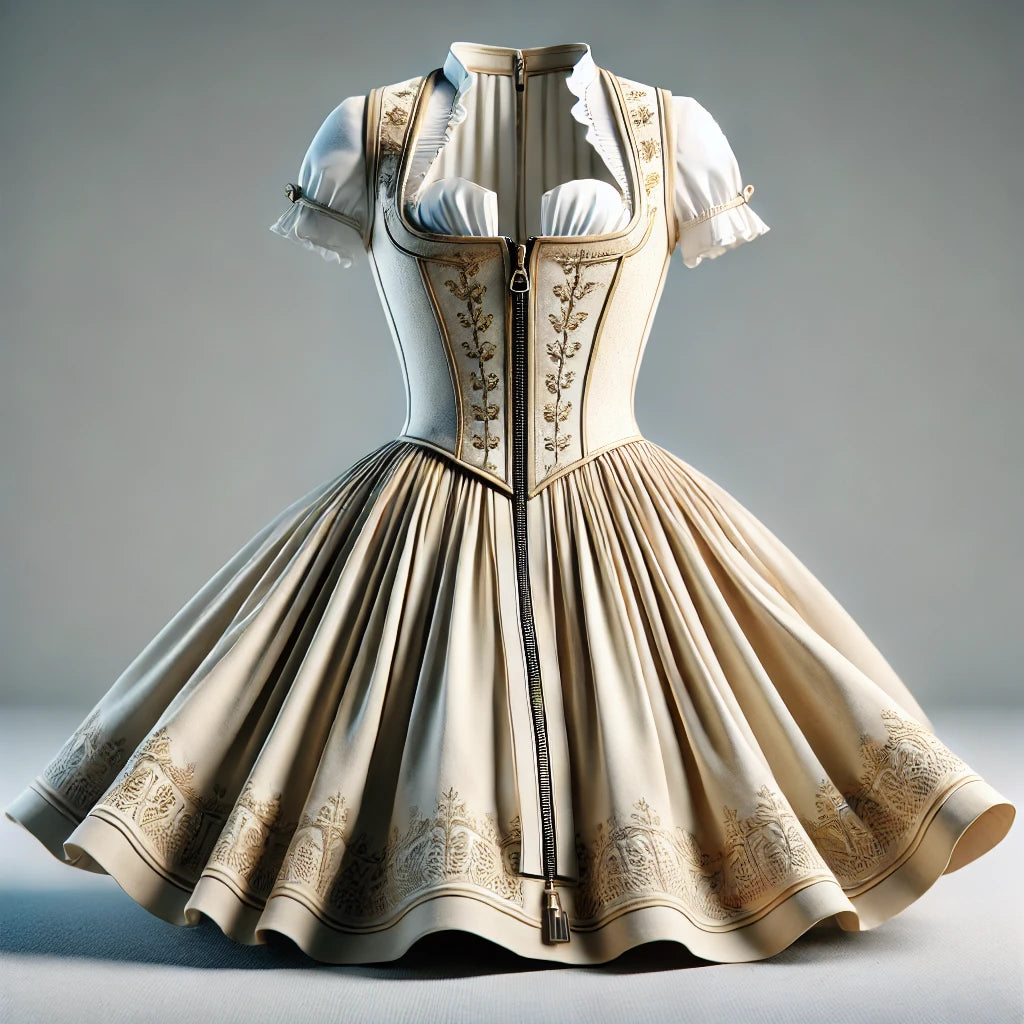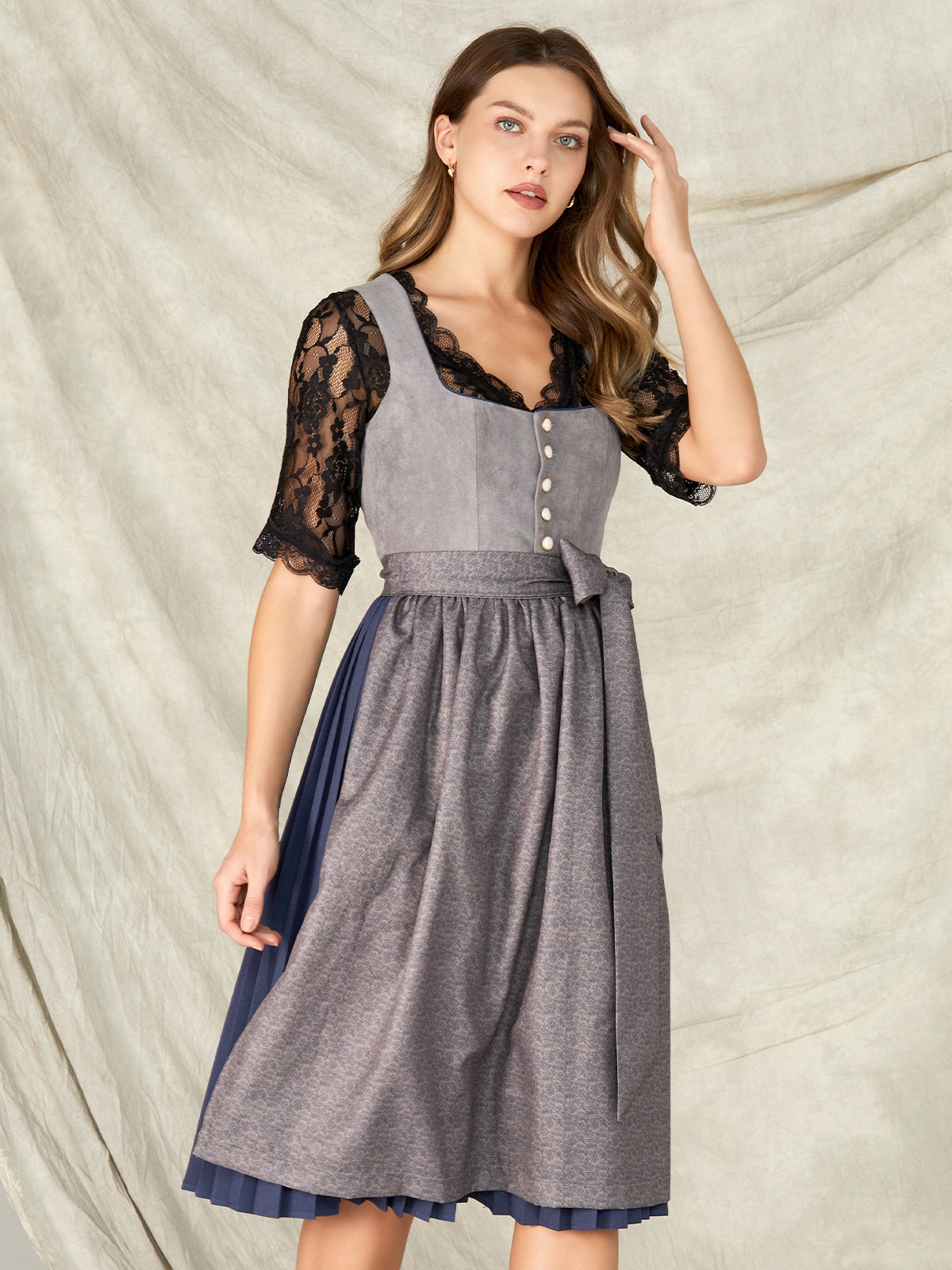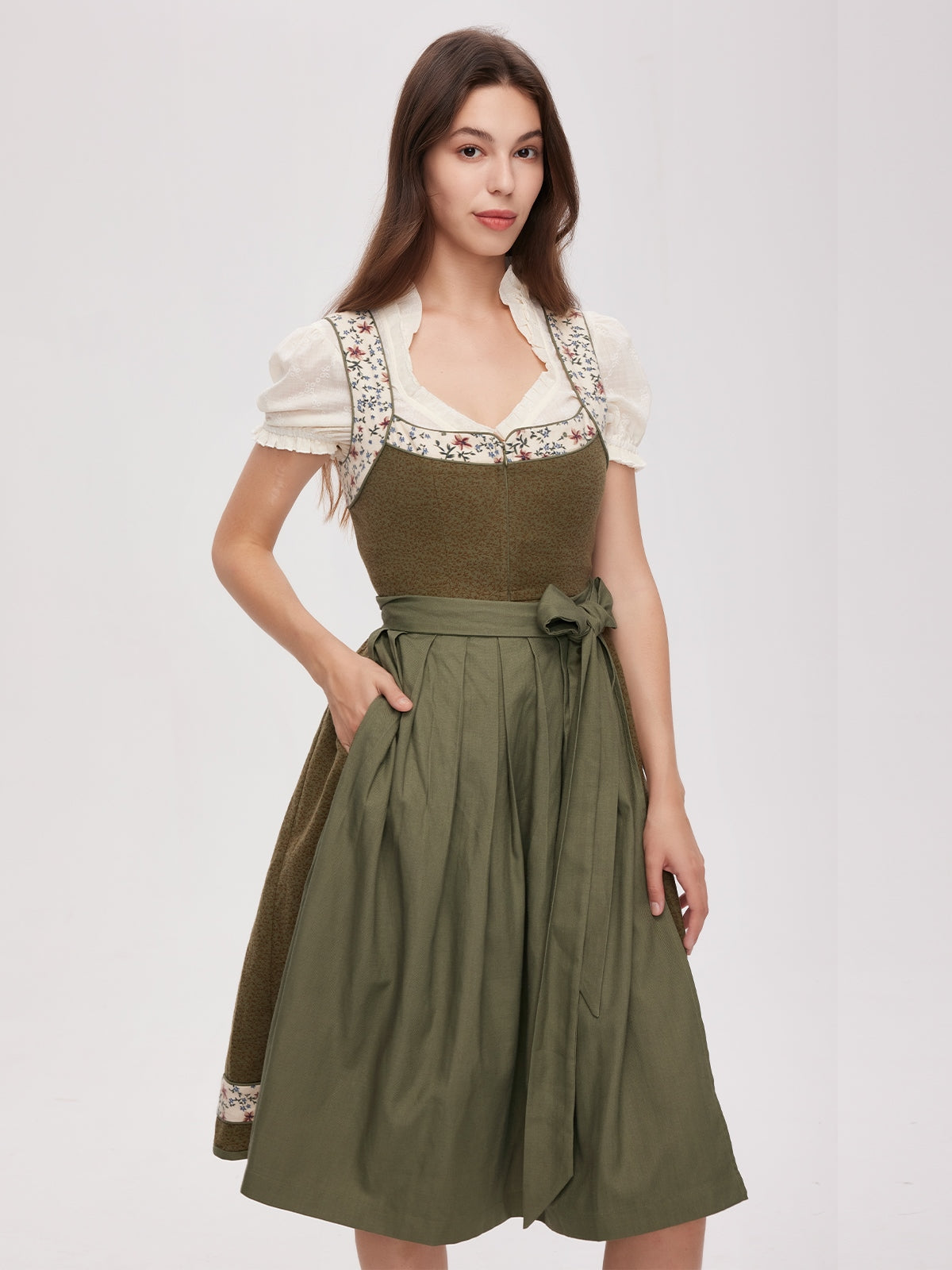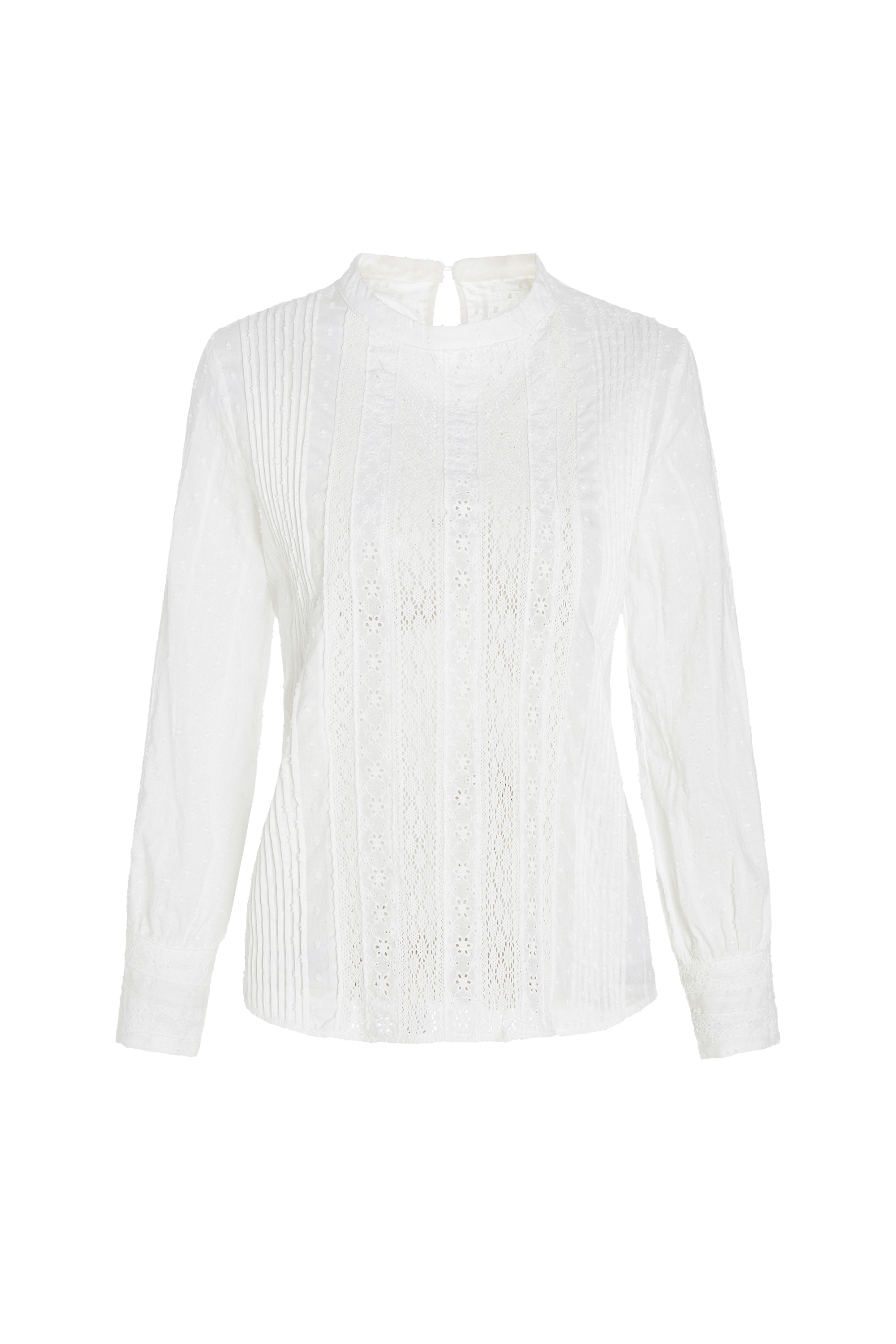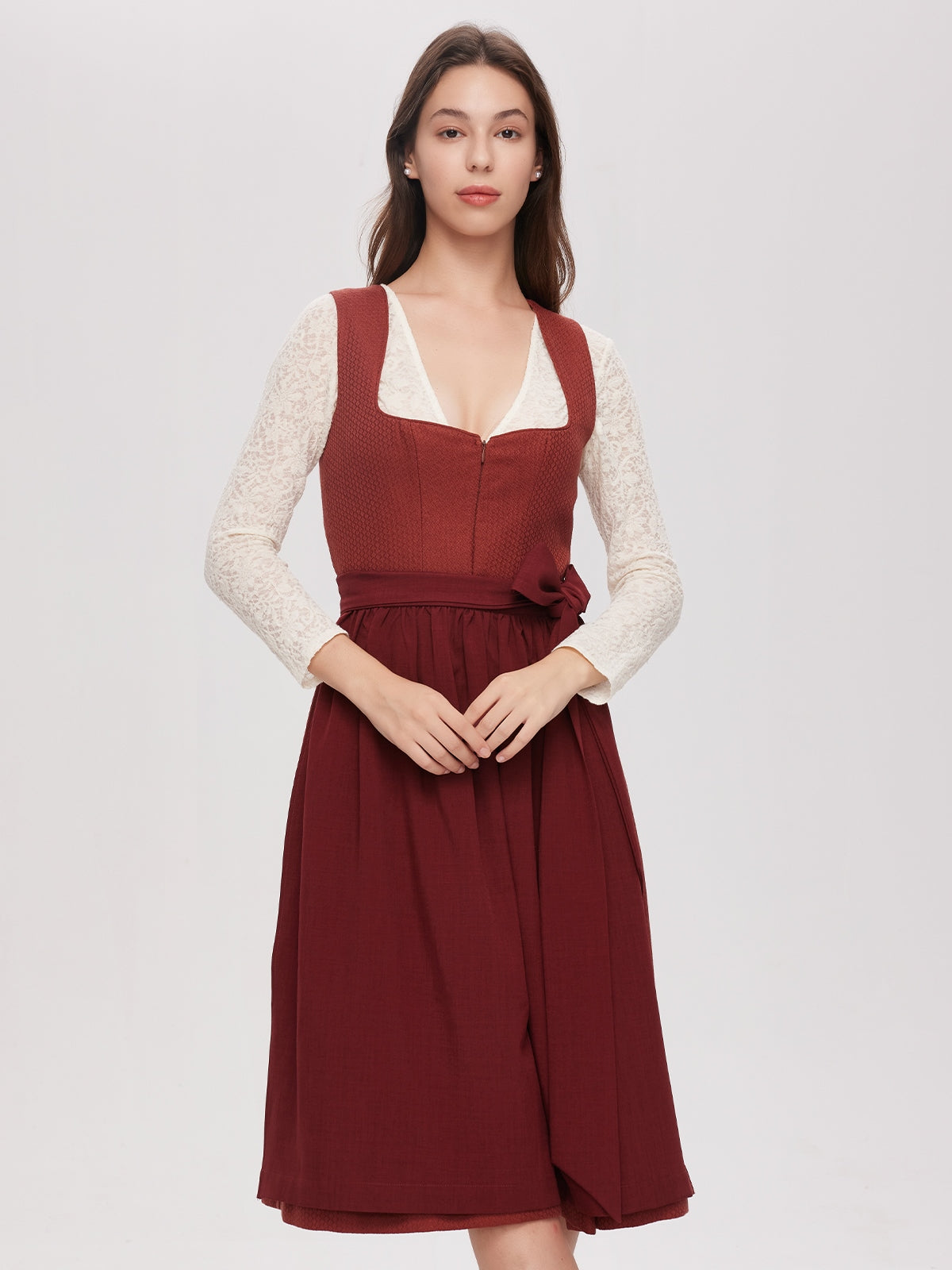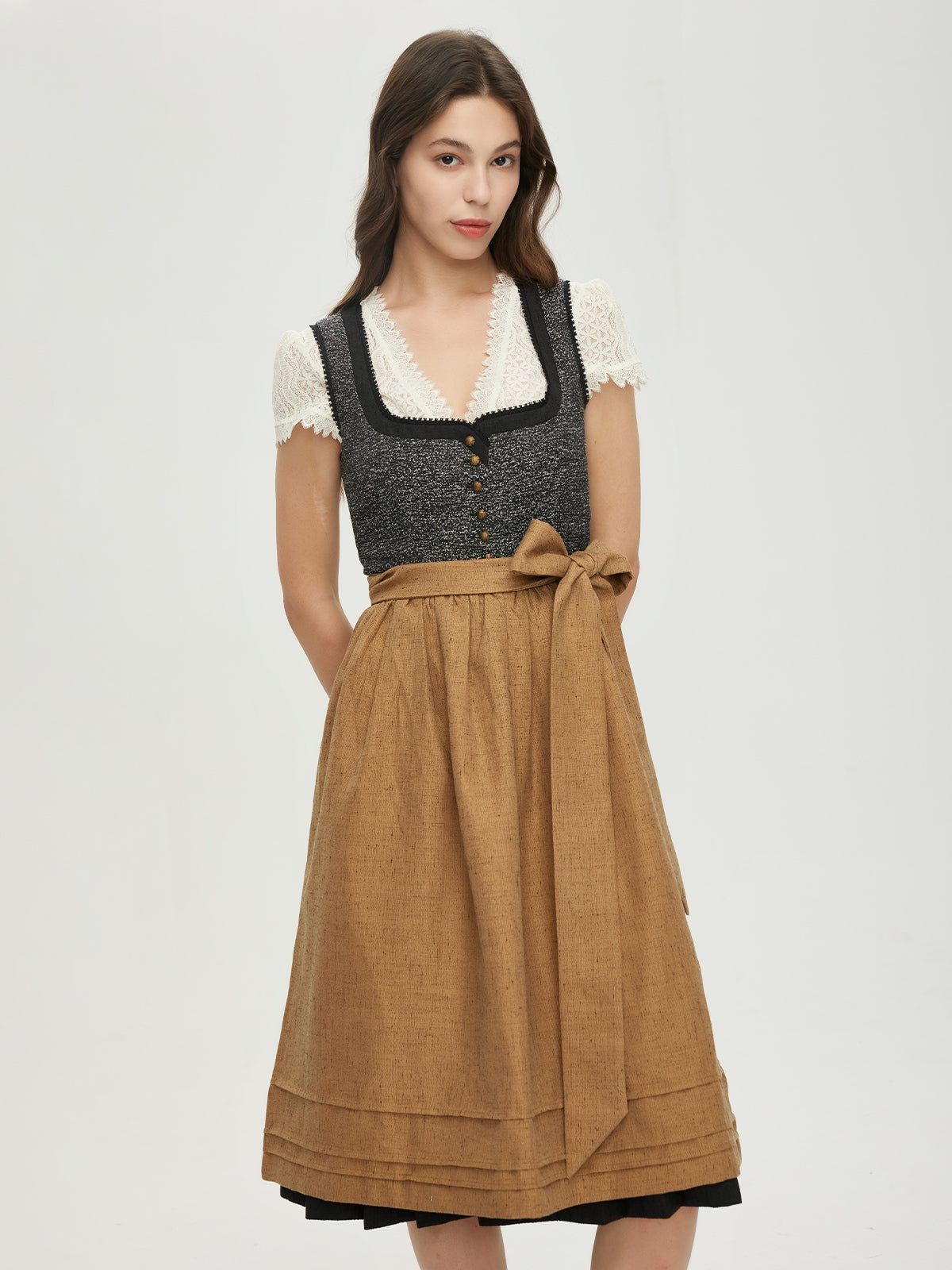Cart
0
The dirndl with a front zipper is a modern interpretation of a traditional garment. While dirndls are traditionally closed with buttons or hooks, the zipper offers a simple and practical alternative. Women seeking both elegance and comfort appreciate this feature. The dirndl's front zipper allows for easy dressing and undressing without compromising the classic look of the dirndl. But what does this small change mean for the wearer? How does it affect the wearer's comfort, self-perception, and even their emotional connection to the traditional costume?
In this story, we accompany Anna as she chooses a dirndl with a zipper down the front, embarking on an emotional journey. The decision for or against a zipper is presented here not only as a fashion choice, but also as a symbolic one—a reflection of Anna's inner world and her personal conflicts.
The importance of the front zipper: practical and stylish
Most dirndl wearers are familiar with the problem: Putting on and taking off a traditional dirndl with its many buttons and hooks can be particularly time-consuming. The front zipper dirndl offers a modern solution. The zipper is discreet and doesn't detract from the dirndl's aesthetic appearance. At the same time, it adds a modern touch to the garment and increases its usability.
The dirndl's front zipper is especially practical for women who need to slip into their dirndl quickly and frequently, whether for a party, Oktoberfest, or other festive occasions. It's not only functional but also stylish, as it creates a smooth silhouette that preserves the traditional charm of the dirndl.
Anna's decision: An inner monologue
Anna stood in front of her closet, examining the dirndl with a zipper down the front that she had recently purchased. It hung quietly and inconspicuously among the other dresses, but to Anna, it represented more than just a new addition to her wardrobe. "A dirndl with a zipper?" she wondered quietly, absentmindedly stroking the fabric. Before, she would never have considered wearing a dirndl that deviated from tradition. But something inside her had changed.
"Is this really still traditional?" the thought came suddenly and unexpectedly. She tried to ignore it, but the doubts remained. Anna remembered her grandmother's words, who always said, "A dirndl must have buttons. That's the right way." These words echoed in her head as she slowly unzipped and zipped up her dirndl. "But isn't it easier? More practical?" she asked herself, trying to banish the uncertainty.
The emerging thoughts: Tradition versus modernity
As Anna repeatedly zipped and unzipped the dress, she realized it wasn't just the zipper that bothered her. It was the question of whether she was ready to deviate from the old traditions her family had cultivated for generations. Her mother and grandmother always wore dirndls with buttons, and for them, these details were an expression of tradition and identity.
"But why should a zipper change that?" she suddenly asked herself. This question popped into her head so unexpectedly that she had to pause. Anna felt her inner world, shaped by her family's values and traditions, begin to falter. The zipper was more than just a functional detail—it symbolized a deeper change in her life. Was she ready to embrace this change?
The Dirndl as a reflection of inner conflicts
Almost unconsciously, the dirndl with its zippered front became a reflection of Anna's inner conflicts. On the one hand, she valued tradition and felt a sense of obligation to her family. On the other, she wanted to break free from these expectations and forge her own path. In that moment, the dirndl became a symbol of this inner conflict.
She remembered past moments when she had tried to fulfill others' expectations, only to lose herself in the process. "I've always conformed," she thought, stroking the dirndl fabric again. "Maybe it's time to do something differently." The zipper seemed, in that moment, not just a practical detail, but a metaphor for the freedom to make one's own decisions—even if they deviated from expectations.
A decision with emotional depth: A sudden change
It was a quiet afternoon when Anna decided to wear the dirndl with the zipper up the front to the next family celebration. The decision came suddenly, almost like an inspiration. "I'll do it," she whispered resolutely. But no sooner had she uttered these words than a wave of doubt swept through her. "What will they say?" she thought.
But this time she didn't let her fears guide her. The thoughts that had tormented her before began to dissipate. "It's my dirndl, my decision," she told herself firmly, feeling an inner strength rising within her. The zipper that she had repeatedly opened and closed was now firmly closed—as was her resolve to follow this path.
The family celebration: An encounter with the past
As Anna arrived at the party, she felt her family's eyes on her. Her mother, dressed in a traditional button-fronted dirndl, looked at her scrutinizingly. "Is that a zipper?" she asked, and Anna felt her heart race. She nodded and waited for their reaction.
But what followed wasn't what she had expected. "Well, it looks very good," her mother said after a brief pause. "It's different, but it suits you." This unexpected approval made Anna breathe a sigh of relief. She had expected resistance, but instead, she found acceptance.
This moment was more than just a relief for Anna. It was a sign that she could follow her own path without denying her family roots. The dirndl's front zipper , which had given her so much thought, had become a symbol of her inner freedom—and a sign that tradition and modernity could exist in harmony.
The emotional reflection: The zipper as a symbol of self-determination
After the festival, Anna reflected on her decision to wear the dirndl with the zipper down the front. It was not only a practical advantage, but also an expression of her self-determination. The zipper, which had initially caused her so much insecurity, was now a sign that she could make her own decisions—without putting the expectations of others above her own needs.
Her mother's words repeated themselves in her head: "It suits you." This sentence had a deeper meaning than she had initially realized. It wasn't just about how the dirndl looked, but about the fact that she had finally made a decision that suited her—who she was and who she wanted to be.
The zipper as a turning point: A new perspective on fashion and tradition
The dirndl with a front zipper may at first glance seem like a small change in traditional design, but for women like Anna, it symbolizes an important step. It represents the connection between tradition and modernity, the freedom to make one's own decisions, and the opportunity to remain true to oneself without denying the past.
The zipper becomes a symbol of a turning point—not only in fashion, but also in Anna's life. It demonstrates that change doesn't always mean a break with tradition, but can also represent further development and adaptation to one's own needs.
Conclusion: The dirndl with a front zipper – a choice for the modern woman
A dirndl with a front zipper not only offers practical advantages but also symbolizes the modern woman who follows her own path. It combines the beauty and tradition of the dirndl with the functionality and simplicity valued today. For women who want to both preserve their roots and express their individuality, the dirndl with a zipper is the perfect choice.
Anna's story shows that fashion is not just an external decision, but also an internal one. The dirndl with a front zipper became a symbol of her self-determination and her willingness to embrace traditions in her own way. For every woman who wants to feel free and authentic in her clothing, the dirndl with a front zipper is a statement that goes beyond fashion—it is a reflection of strength, freedom, and independence.
In this story, we accompany Anna as she chooses a dirndl with a zipper down the front, embarking on an emotional journey. The decision for or against a zipper is presented here not only as a fashion choice, but also as a symbolic one—a reflection of Anna's inner world and her personal conflicts.
The importance of the front zipper: practical and stylish
Most dirndl wearers are familiar with the problem: Putting on and taking off a traditional dirndl with its many buttons and hooks can be particularly time-consuming. The front zipper dirndl offers a modern solution. The zipper is discreet and doesn't detract from the dirndl's aesthetic appearance. At the same time, it adds a modern touch to the garment and increases its usability.
The dirndl's front zipper is especially practical for women who need to slip into their dirndl quickly and frequently, whether for a party, Oktoberfest, or other festive occasions. It's not only functional but also stylish, as it creates a smooth silhouette that preserves the traditional charm of the dirndl.
Anna's decision: An inner monologue
Anna stood in front of her closet, examining the dirndl with a zipper down the front that she had recently purchased. It hung quietly and inconspicuously among the other dresses, but to Anna, it represented more than just a new addition to her wardrobe. "A dirndl with a zipper?" she wondered quietly, absentmindedly stroking the fabric. Before, she would never have considered wearing a dirndl that deviated from tradition. But something inside her had changed.
"Is this really still traditional?" the thought came suddenly and unexpectedly. She tried to ignore it, but the doubts remained. Anna remembered her grandmother's words, who always said, "A dirndl must have buttons. That's the right way." These words echoed in her head as she slowly unzipped and zipped up her dirndl. "But isn't it easier? More practical?" she asked herself, trying to banish the uncertainty.
The emerging thoughts: Tradition versus modernity
As Anna repeatedly zipped and unzipped the dress, she realized it wasn't just the zipper that bothered her. It was the question of whether she was ready to deviate from the old traditions her family had cultivated for generations. Her mother and grandmother always wore dirndls with buttons, and for them, these details were an expression of tradition and identity.
"But why should a zipper change that?" she suddenly asked herself. This question popped into her head so unexpectedly that she had to pause. Anna felt her inner world, shaped by her family's values and traditions, begin to falter. The zipper was more than just a functional detail—it symbolized a deeper change in her life. Was she ready to embrace this change?
The Dirndl as a reflection of inner conflicts
Almost unconsciously, the dirndl with its zippered front became a reflection of Anna's inner conflicts. On the one hand, she valued tradition and felt a sense of obligation to her family. On the other, she wanted to break free from these expectations and forge her own path. In that moment, the dirndl became a symbol of this inner conflict.
She remembered past moments when she had tried to fulfill others' expectations, only to lose herself in the process. "I've always conformed," she thought, stroking the dirndl fabric again. "Maybe it's time to do something differently." The zipper seemed, in that moment, not just a practical detail, but a metaphor for the freedom to make one's own decisions—even if they deviated from expectations.
A decision with emotional depth: A sudden change
It was a quiet afternoon when Anna decided to wear the dirndl with the zipper up the front to the next family celebration. The decision came suddenly, almost like an inspiration. "I'll do it," she whispered resolutely. But no sooner had she uttered these words than a wave of doubt swept through her. "What will they say?" she thought.
But this time she didn't let her fears guide her. The thoughts that had tormented her before began to dissipate. "It's my dirndl, my decision," she told herself firmly, feeling an inner strength rising within her. The zipper that she had repeatedly opened and closed was now firmly closed—as was her resolve to follow this path.
The family celebration: An encounter with the past
As Anna arrived at the party, she felt her family's eyes on her. Her mother, dressed in a traditional button-fronted dirndl, looked at her scrutinizingly. "Is that a zipper?" she asked, and Anna felt her heart race. She nodded and waited for their reaction.
But what followed wasn't what she had expected. "Well, it looks very good," her mother said after a brief pause. "It's different, but it suits you." This unexpected approval made Anna breathe a sigh of relief. She had expected resistance, but instead, she found acceptance.
This moment was more than just a relief for Anna. It was a sign that she could follow her own path without denying her family roots. The dirndl's front zipper , which had given her so much thought, had become a symbol of her inner freedom—and a sign that tradition and modernity could exist in harmony.
The emotional reflection: The zipper as a symbol of self-determination
After the festival, Anna reflected on her decision to wear the dirndl with the zipper down the front. It was not only a practical advantage, but also an expression of her self-determination. The zipper, which had initially caused her so much insecurity, was now a sign that she could make her own decisions—without putting the expectations of others above her own needs.
Her mother's words repeated themselves in her head: "It suits you." This sentence had a deeper meaning than she had initially realized. It wasn't just about how the dirndl looked, but about the fact that she had finally made a decision that suited her—who she was and who she wanted to be.
The zipper as a turning point: A new perspective on fashion and tradition
The dirndl with a front zipper may at first glance seem like a small change in traditional design, but for women like Anna, it symbolizes an important step. It represents the connection between tradition and modernity, the freedom to make one's own decisions, and the opportunity to remain true to oneself without denying the past.
The zipper becomes a symbol of a turning point—not only in fashion, but also in Anna's life. It demonstrates that change doesn't always mean a break with tradition, but can also represent further development and adaptation to one's own needs.
Conclusion: The dirndl with a front zipper – a choice for the modern woman
A dirndl with a front zipper not only offers practical advantages but also symbolizes the modern woman who follows her own path. It combines the beauty and tradition of the dirndl with the functionality and simplicity valued today. For women who want to both preserve their roots and express their individuality, the dirndl with a zipper is the perfect choice.
Anna's story shows that fashion is not just an external decision, but also an internal one. The dirndl with a front zipper became a symbol of her self-determination and her willingness to embrace traditions in her own way. For every woman who wants to feel free and authentic in her clothing, the dirndl with a front zipper is a statement that goes beyond fashion—it is a reflection of strength, freedom, and independence.

